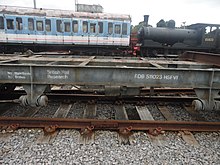20:
43:
performed at 90 mph (140 km/h) whilst under test on the main line. Its suspension had two vertical coil springs and two vertical and one lateral hydraulic damper at each corner of the vehicle. This was at a time when few freight trains travelled at more than 40 mph (65 km/h) and most passenger trains averaged about 70 mph (110 km/h). It supported theories of vehicle design which led to most later designs of train.
66:
dampers inclined at 45 degrees to effect both vertical and lateral movement. On test these vehicles were capable of 90 mph (140 km/h) but in service were limited to 75 mph (120 km/h) due to their running with other UIC long-link suspension vans. Ultimately they were converted to
74:
in
Coventry, but that museum is now closed. HSFV1 was donated to the APT-E preservation Group by Serco after the National Railway Museum chose not to preserve it, but NRM have recently relented and it is now displayed at Shildon alongside the restored APT-E, which after all benefitted from the
42:
HSFV1 was intended for fundamental empirical research into wheel-rail interaction and suspension dynamics to be better understood, following from work on wheel tread profiles. It was regularly run at speeds of up to 140 mph (230 km/h) on the
Vehicles Laboratory's roller rig. It also
50:
Although they were excellent riding vehicles in the railway of the day they were viewed as experimental only and far too expensive for widespread adoption. It was also thought that the sophisticated suspension would not stand up to the daily rigours to which freight vehicles were subjected.
46:
A similar converted UIC long-wheelbase four-wheeled ferry van (HSFV4) was utilised for high-speed trials. HSFV4 had two coil springs with two 45-degree-inclined hydraulic dampers and a traction rod at each corner.
78:
A number of vehicles were produced, including HSFV1 and HSFV4, with various tests being carried out between 1975 and 1979. A variant of HSFV1 formed the basis for the suspension of the
70:
HSFV1 survived until recently in Serco stock at the RTC, but in May 2010 was moved out on its way to preservation. It was intended that it would eventually be displayed at the
75:
fundamental research carried out into wheel/rail interaction with HSFV1. HSFV4 is also still extant at the Eden Valley
Railway where it is undergoing restoration.
67:
standard after a few years, except two examples. One of these was used by the R&DD on the
Tribometer train and one by the DM&EE on their own test trains.
252:
35:
was a generic term for a number of prototype four-wheeled rail vehicles which were fitted with various experimental suspensions developed by the
39:
in the late 1960s. The development was part of the investigation into the riding of vehicles and the interaction between wheel and rail.
247:
185:"MEASUREMENT OF WHEEL-RAIL CONTACT FORCES AT A SELECTION OF SWITCHES AND CROSSINGS USING HSFV1 EQUIPPED WITH LOAD MEASURING WHEELSETS"
24:
36:
184:
152:
54:
However in the early 1970s these experiments resulted in ten covered air-braked vans (COV-AB) being fitted with
71:
79:
55:
19:
241:
82:
191:
159:
59:
127:
63:
216:
102:
18:
153:"RESULTS OF THE 1975 CURVING TESTS WITH HSFV1 IN CORNWALL"
25:Locomotion: the National Railway Museum at Shildon
8:
103:"High speed freight vehicle suspensions"
94:
253:British Rail research and development
7:
14:
16:British prototype railway vehicle
37:British Rail Research Division
1:
58:consisting of a long double
269:
248:British Rail rolling stock
33:High Speed Freight Vehicle
72:Electric Railway Museum
28:
128:"LMW plus ride tests"
22:
56:Taperlite suspension
23:HSFV1 found at the
165:on 5 November 2004
29:
260:
232:
231:
229:
227:
221:TrainTesting.com
213:
207:
206:
204:
202:
196:
190:. Archived from
189:
181:
175:
174:
172:
170:
164:
158:. Archived from
157:
149:
143:
142:
140:
138:
132:TrainTesting.com
124:
118:
117:
115:
113:
107:TrainTesting.com
99:
268:
267:
263:
262:
261:
259:
258:
257:
238:
237:
236:
235:
225:
223:
217:"Decapod Lab25"
215:
214:
210:
200:
198:
197:on 19 July 2011
194:
187:
183:
182:
178:
168:
166:
162:
155:
151:
150:
146:
136:
134:
126:
125:
121:
111:
109:
101:
100:
96:
91:
17:
12:
11:
5:
266:
264:
256:
255:
250:
240:
239:
234:
233:
208:
176:
144:
119:
93:
92:
90:
87:
15:
13:
10:
9:
6:
4:
3:
2:
265:
254:
251:
249:
246:
245:
243:
222:
218:
212:
209:
193:
186:
180:
177:
161:
154:
148:
145:
133:
129:
123:
120:
108:
104:
98:
95:
88:
86:
84:
81:
76:
73:
68:
65:
61:
57:
52:
48:
44:
40:
38:
34:
26:
21:
224:. Retrieved
220:
211:
199:. Retrieved
192:the original
179:
167:. Retrieved
160:the original
147:
135:. Retrieved
131:
122:
110:. Retrieved
106:
97:
77:
69:
62:and having
53:
49:
45:
41:
32:
30:
201:21 February
169:21 February
60:leaf spring
242:Categories
112:3 February
89:References
85:railbus.
80:Class 140
64:hydraulic
226:4 March
137:4 March
195:(PDF)
188:(PDF)
163:(PDF)
156:(PDF)
83:Pacer
228:2017
203:2008
171:2008
139:2017
114:2018
31:The
244::
219:.
130:.
105:.
230:.
205:.
173:.
141:.
116:.
27:.
Text is available under the Creative Commons Attribution-ShareAlike License. Additional terms may apply.
